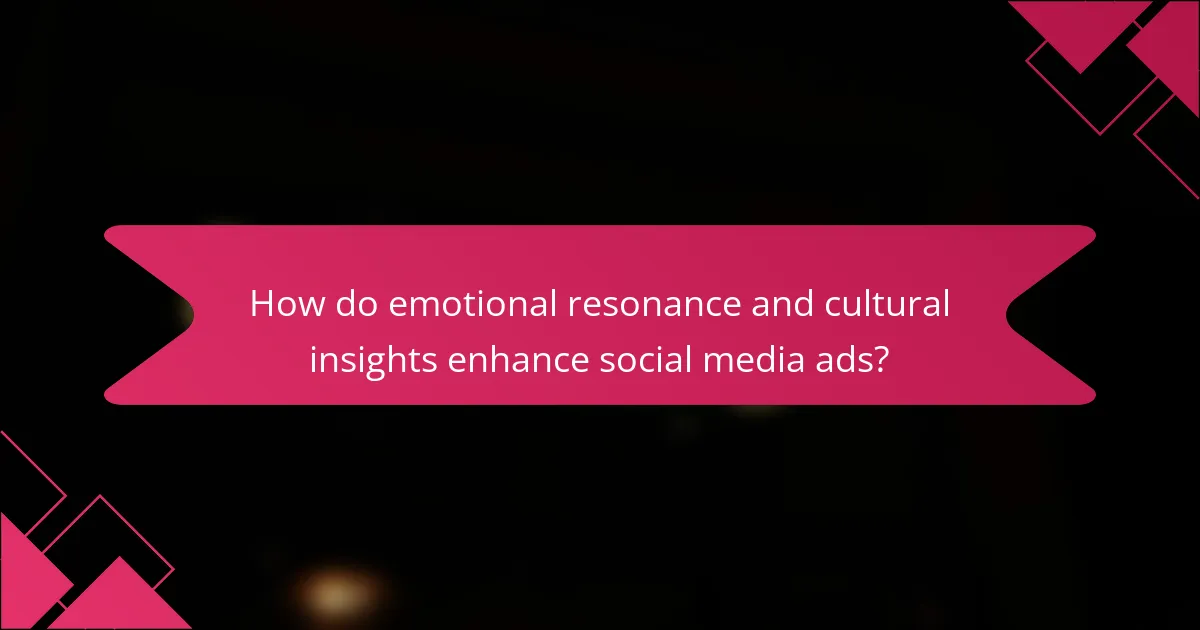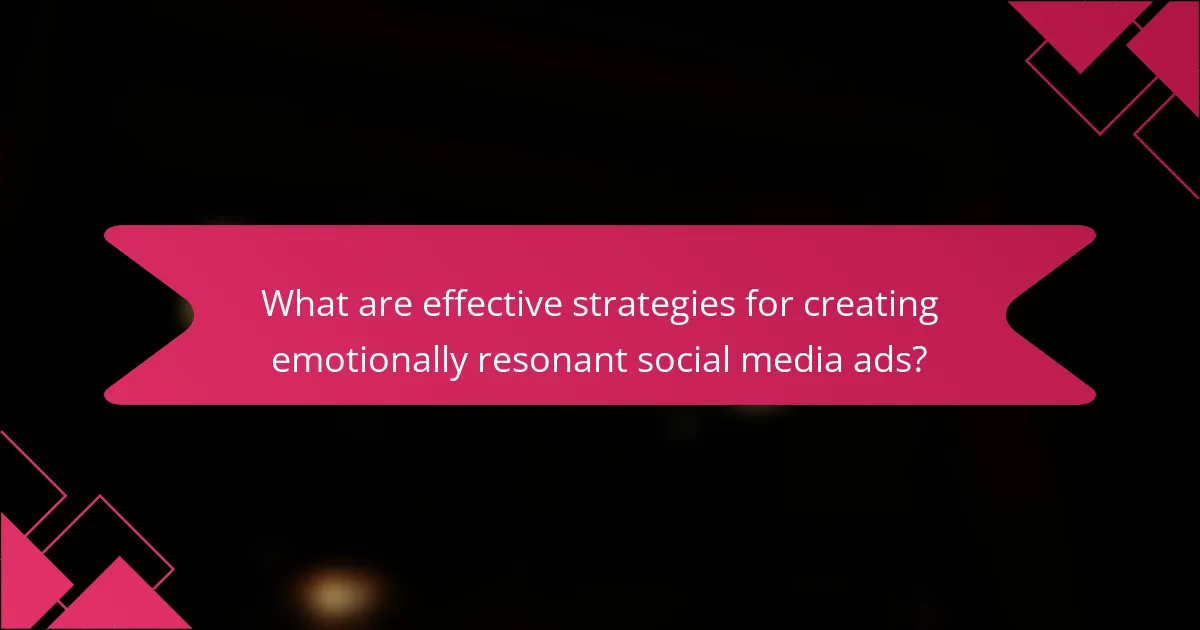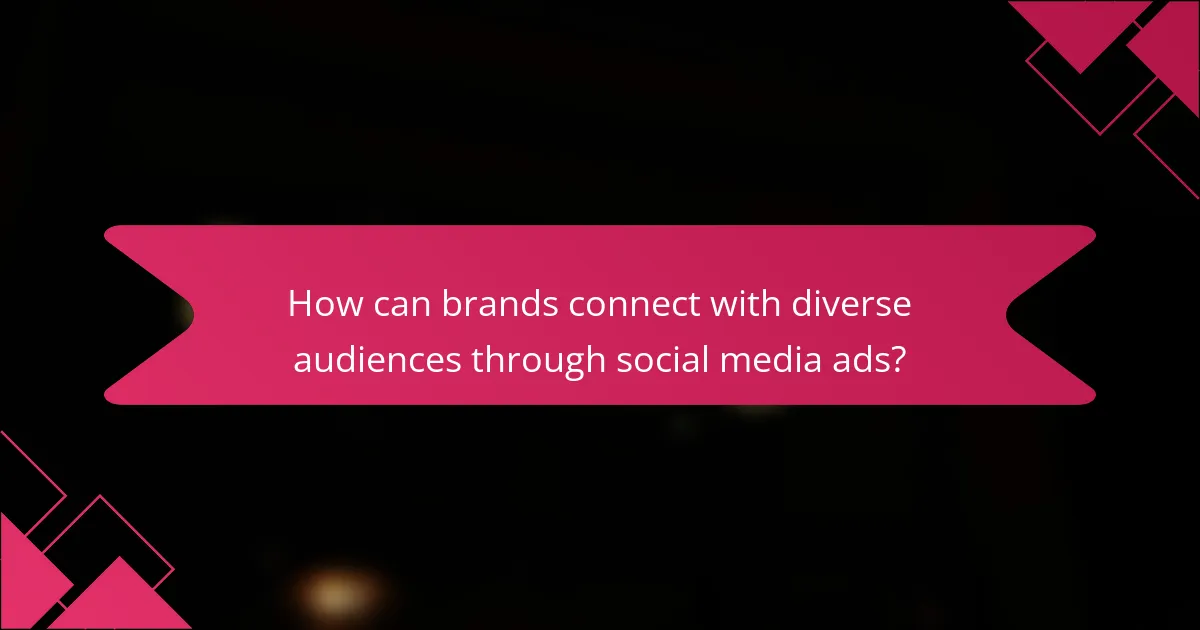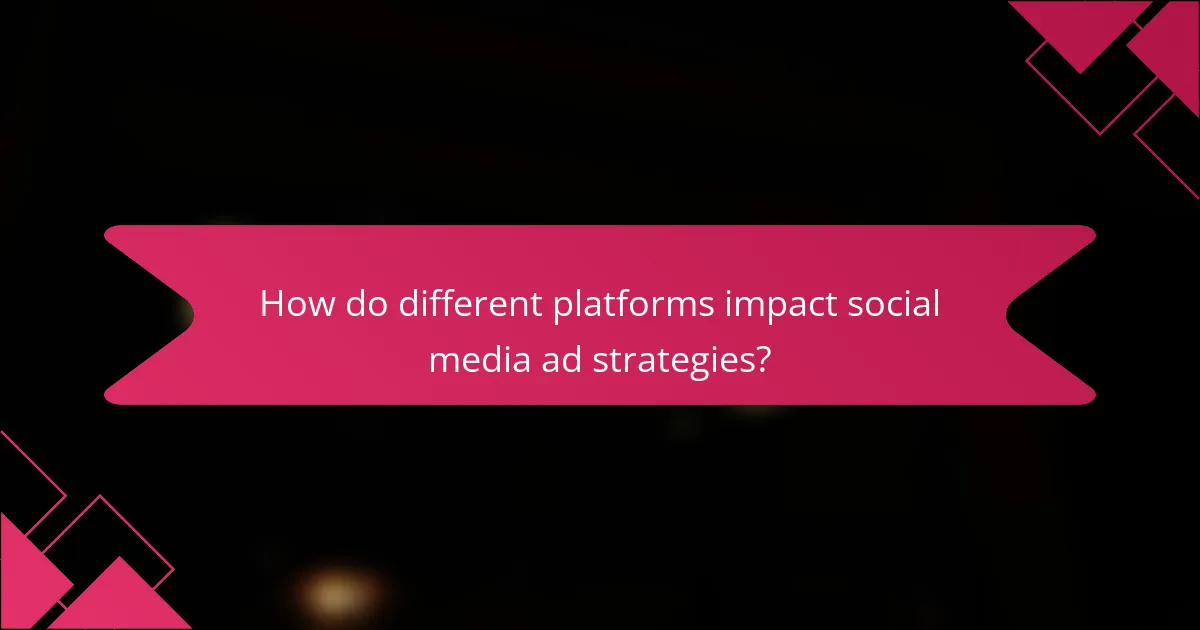Social media ads that harness emotional resonance and cultural insights are pivotal in forging meaningful connections with audiences. By evoking emotions and reflecting cultural contexts, these ads not only engage consumers but also inspire action. Strategies such as utilizing user-generated content and relatable narratives can significantly enhance brand loyalty and engagement.

How do emotional resonance and cultural insights enhance social media ads?
Emotional resonance and cultural insights significantly enhance social media ads by creating deeper connections with audiences. Ads that evoke emotions or reflect cultural contexts are more likely to engage consumers and drive action.
Emotional storytelling
Emotional storytelling involves crafting narratives that resonate with the audience’s feelings and experiences. By using relatable characters and situations, brands can evoke empathy, joy, or nostalgia, making the ad memorable. For example, a campaign that tells a heartfelt story about family gatherings during holidays can create a strong emotional bond with viewers.
To effectively use emotional storytelling, identify the core emotion you want to evoke and ensure it aligns with your brand message. Avoid clichés; instead, focus on authentic stories that reflect real-life experiences.
Cultural relevance
Cultural relevance ensures that ads resonate with specific cultural contexts and values. By understanding local customs, language, and social issues, brands can create content that feels familiar and respectful to the target audience. For instance, an ad campaign that acknowledges local festivals or traditions can enhance relatability and acceptance.
To achieve cultural relevance, conduct thorough research on the target demographic’s cultural background. Collaborate with local influencers or experts to ensure the messaging is appropriate and resonates well with the audience.
Consumer engagement
Consumer engagement is the interaction between the brand and its audience, driven by emotional and cultural connections. Engaging ads encourage viewers to like, share, or comment, fostering a sense of community. For example, campaigns that invite user-generated content can significantly boost engagement rates.
To enhance consumer engagement, create interactive elements such as polls, quizzes, or challenges that encourage participation. Monitor feedback and adapt your strategies based on audience responses to maintain relevance and interest.

What are effective strategies for creating emotionally resonant social media ads?
Effective strategies for creating emotionally resonant social media ads include tapping into user-generated content, incorporating relatable narratives, and leveraging humor and empathy. These approaches foster a deeper connection with audiences, enhancing engagement and brand loyalty.
Utilizing user-generated content
User-generated content (UGC) involves showcasing real customers’ experiences with your brand, which can significantly enhance emotional resonance. By featuring testimonials, photos, or videos shared by users, brands can create authenticity and trust.
To effectively use UGC, encourage customers to share their stories through contests or hashtags. Highlighting these contributions not only builds community but also provides relatable content that potential customers can connect with.
Incorporating relatable narratives
Relatable narratives resonate with audiences by reflecting their own experiences and emotions. Crafting stories that mirror common challenges or aspirations can create a strong emotional bond with viewers.
Consider using scenarios that your target audience faces daily. For example, a brand selling home goods might depict a family gathering, showcasing the warmth and connection that products can foster. This approach makes the ad more impactful and memorable.
Leveraging humor and empathy
Humor and empathy can be powerful tools in social media advertising, as they evoke positive emotions and foster connection. Ads that make people laugh or feel understood can enhance shareability and engagement.
When using humor, ensure it aligns with your brand’s voice and resonates with your audience’s values. Empathy can be expressed through messages that acknowledge struggles or celebrate achievements, making your brand appear more relatable and compassionate.

How can brands connect with diverse audiences through social media ads?
Brands can effectively connect with diverse audiences through social media ads by employing strategies that resonate emotionally and culturally. Understanding the unique preferences and values of different demographic groups is essential for crafting impactful messages.
Targeted messaging
Targeted messaging involves creating ads that speak directly to specific audience segments based on their interests, demographics, and behaviors. By utilizing data analytics, brands can identify key characteristics of their target groups and tailor their content accordingly.
For example, a brand might create separate ad campaigns for millennials and baby boomers, focusing on the values and trends that resonate with each group. This approach increases engagement and improves the likelihood of conversion.
Cultural representation
Cultural representation in social media ads is crucial for fostering authenticity and trust among diverse audiences. Brands should ensure that their advertisements reflect the cultural backgrounds and experiences of the communities they aim to reach.
Incorporating diverse actors, languages, and cultural symbols can enhance relatability. For instance, a campaign featuring local influencers from various ethnic backgrounds can strengthen connections with those communities, making the brand more appealing.
Localized content
Localized content refers to adapting ads to fit the cultural and linguistic context of specific regions. This strategy involves not only translating text but also considering local customs, values, and preferences.
For example, a global brand might modify its messaging to align with local holidays or events, using relevant imagery and language. This approach can significantly improve engagement rates, as audiences feel the content speaks directly to their experiences.

What role do analytics play in optimizing social media ads?
Analytics are crucial for optimizing social media ads as they provide data-driven insights into ad performance, audience engagement, and overall effectiveness. By leveraging analytics, marketers can make informed decisions to enhance their campaigns and improve return on investment.
Performance tracking
Performance tracking involves monitoring key metrics such as click-through rates, conversion rates, and engagement levels. These metrics help identify which ads resonate with the audience and which do not. Regularly reviewing performance data allows marketers to adjust their strategies in real-time, ensuring better outcomes.
For effective performance tracking, set clear goals for each campaign. Use tools like Google Analytics or social media insights to gather data. Aim for a consistent review schedule, such as weekly or bi-weekly, to stay on top of trends and shifts in audience behavior.
A/B testing
A/B testing, or split testing, is a method used to compare two versions of an ad to determine which performs better. By changing one variable at a time—such as the headline, image, or call-to-action—marketers can isolate factors that contribute to success. This approach leads to more effective ads over time.
When conducting A/B tests, ensure you have a significant sample size to yield reliable results. Run tests for a sufficient duration, typically a few days to a week, to account for variations in user behavior. Analyze the results to inform future campaigns and refine your advertising strategy.
Audience insights
Audience insights provide valuable information about the demographics, interests, and behaviors of your target market. Understanding these factors enables marketers to tailor their ads to better meet the needs and preferences of their audience. This connection can significantly enhance engagement and conversion rates.
Utilize tools like Facebook Audience Insights or Instagram Analytics to gather data on your audience. Look for trends in age, location, and interests to inform your ad content and targeting strategies. Regularly update your audience profiles based on new data to maintain relevance in your campaigns.

What are the key metrics for measuring the success of social media ads?
The key metrics for measuring the success of social media ads include engagement rates, conversion rates, and return on ad spend (ROAS). These metrics provide insights into how well ads resonate with audiences and their effectiveness in driving desired actions.
Engagement rates
Engagement rates indicate how actively users interact with your social media ads. This metric typically includes likes, shares, comments, and clicks, reflecting the ad’s ability to capture attention and provoke a response.
A high engagement rate, often in the range of 1-5%, suggests that the content resonates well with the audience. To improve engagement, focus on creating visually appealing ads and compelling copy that speaks directly to your target demographic.
Conversion rates
Conversion rates measure the percentage of users who take a desired action after interacting with your ad, such as making a purchase or signing up for a newsletter. This metric is crucial for assessing the effectiveness of your ads in driving sales or leads.
Typical conversion rates can vary widely, often falling between 1-3% for e-commerce ads. To enhance conversion rates, ensure your landing pages are optimized for user experience and aligned with the messaging of your ads.
Return on ad spend
Return on ad spend (ROAS) calculates the revenue generated for every dollar spent on advertising. This metric helps determine the financial effectiveness of your ad campaigns and guides budget allocation.
A ROAS of 4:1 is generally considered a good benchmark, meaning for every dollar spent, four dollars are earned. To maximize ROAS, continually analyze ad performance and adjust targeting, creative elements, and bidding strategies based on what drives the best results.

How do different platforms impact social media ad strategies?
Different social media platforms significantly influence ad strategies due to their unique user demographics, engagement patterns, and content formats. Advertisers must tailor their approaches to align with each platform’s strengths to effectively connect with their target audiences.
Facebook vs Instagram
Facebook and Instagram, while both owned by Meta, serve different user experiences and demographics. Facebook is often favored for its extensive targeting options and diverse user base, making it suitable for detailed campaigns aimed at various age groups and interests.
In contrast, Instagram is more visually driven and appeals to a younger audience. Brands should focus on high-quality images and engaging stories on Instagram, while Facebook ads can leverage longer text and links to drive traffic to websites. A common strategy is to use Instagram for brand awareness and Facebook for conversions.
Twitter’s unique audience
Twitter’s audience is characterized by real-time engagement and a preference for concise communication. Ads on Twitter should prioritize brevity and immediacy, often leveraging trending topics or hashtags to capture attention quickly.
Brands can benefit from using Twitter for timely promotions or customer interaction, as users expect quick responses. However, the fast-paced nature of Twitter means that ads need to be compelling and relevant to stand out, often requiring frequent updates to maintain visibility.










